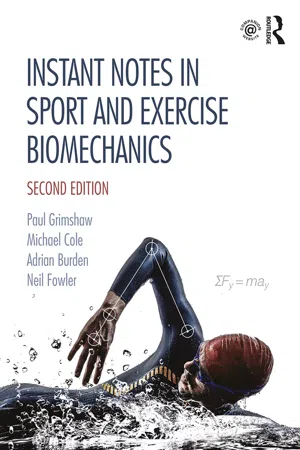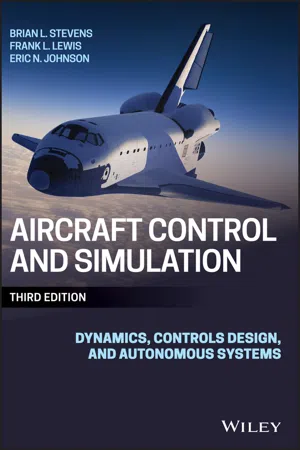Physics
Angular Kinematics
Angular kinematics is the study of the motion of objects in terms of angular displacement, velocity, and acceleration. It focuses on the rotational aspects of motion, such as how an object's orientation changes over time. This branch of physics is essential for understanding the behavior of rotating objects and systems.
Written by Perlego with AI-assistance
Related key terms
1 of 5
12 Key excerpts on "Angular Kinematics"
- eBook - ePub
- Paul Grimshaw, Michael Cole, Adrian Burden, Neil Fowler(Authors)
- 2019(Publication Date)
- Garland Science(Publisher)
SECTION C Kinematics and kinetics of angular motionPassage contains an image
C1 ANGULAR MOTION Paul Grimshaw Angular motion is rotatory movement about an imaginary or real axis of rotation and where all parts on a body (note that the term body need not necessarily be a human body) or segment move through the same angle. Angular Kinematics describes quantities of angular motion using such terms as angular displacement, angular velocity and angular acceleration. Figure C1.1 identifies two examples of angular motion in more detail.Angular distance or displacement (scalar or vector quantity) is usually expressed in the units of degrees (where a complete circle is 360 degrees). Similarly, angular velocity (depicted by the Greek letter omega (ω )) and angular acceleration (depicted by the Greek letter alpha (α )) are often expressed as degrees per second (°/s) and degrees per second squared (°/s2 or degrees/second2 ) respectively. However, it is more convenient within human motion to use the unit radian due to the large amount of angular displacement involved. The value for 1 radian represents an angle of approximately 57.3° and there are 2π (where pi is approximately 3.142) radians in 360 degrees (one circle).As with the terms used to describe linear motion, within angular motion there exists both scalar and vector quantities. However, it is often possible and more easily understandable to describe angular movement using such definitions as clockwise or anti-clockwise rotation. Again, positive and negative signs can be used to denote the different directions (e.g. clockwise rotation may be assigned a negative sign and anti-clockwise rotation a positive sign which is the common convention used within biomechanics).Figure C1.1 Angular motion in sportFigure C1.2 Angular motion during kicking a ballConsidering Figure C1.2 - eBook - ePub
An Introduction to Human Movement and Biomechanics E-Book
An Introduction to Human Movement and Biomechanics E-Book
- Andrew Kerr, Philip Rowe, Andrew Kerr, Philip Rowe(Authors)
- 2019(Publication Date)
- Elsevier(Publisher)
The description of motion using these concepts is known as ‘kinematics’. Kinematics is concerned with the geometry of motion. It seeks to describe motion rather than to explain why it occurs, and for this reason it is considered an observational rather than an analytical discipline. The description of translatory motion is known as ‘linear kinematics’. Linear kinematics use three mechanical variables to describe linear motion, namely linear displacement, linear velocity and linear acceleration (often abbreviated to displacement, velocity and acceleration). The description of rotary motion is known as ‘Angular Kinematics’. Angular Kinematics can be described using a similar set of three mechanical variables, namely angular displacement, angular velocity and angular acceleration. The general motion of an object can therefore be fully described by considering the linear and Angular Kinematics of the object in 3D space. The description of linear and Angular Kinematics therefore introduces six more of the key mechanical variables used to investigate human movement.The third and final point of interest in this definition of motion is that motion takes place ‘with respect to some reference point or object’. The reference point or object can be any point in the universe and is very influential in determining what we ‘see’. As an example, consider passengers on a train passing a station. They will ‘see’ the station pass by through the windows while their fellow travellers on the train remain in the same position. They will interpret this as the train moving through the station and leaving it behind. However, it could be that the train is not moving and the station is! The passengers would receive the same visual information as before and would be likely to interpret it as before. It is not very often that you see stations on the move, so in this case the chances of being wrong are small.However, if you take two objects that we know move around then it is not always so clear which is moving and which is stationary. Imagine sitting in a train in a station when the train at an adjoining platform starts to move. Initially we may think that our train has begun to move and the other train is stationary. It is only when we fail to ‘feel’ the motion of our train or we observe that other objects, such as the station, have not changed location that we interpret the situation as the other train moving while we are stationary. - eBook - PDF
- John D. Cutnell, Kenneth W. Johnson, David Young, Shane Stadler(Authors)
- 2018(Publication Date)
- Wiley(Publisher)
LEARNING OBJECTIVES After reading this module, you should be able to... 8.1 Define angular displacement. 8.2 Define angular velocity and angular acceleration. 8.3 Solve rotational kinematics problems. 8.4 Relate angular and tangential variables. 8.5 Distinguish between centripetal and tangential accelerations. 8.6 Analyze rolling motion. 8.7 Use the right-hand rule to determine the direction of angular vectors. Mikhail Starodubov/Shutterstock CHAPTER 8 Rotational Kinematics The figure shows the front view of a turbine jet engine on a commercial aircraft. The rotating fan blades collect air into the engine before it is compressed, mixed with fuel, and ignited to produce thrust. The rotational motion of the blades can be described using the concepts of angular displacement, angular velocity, and angular acceleration within the framework of rotational kinematics. 8.1 Rotational Motion and Angular Displacement In the simplest kind of rotation, points on a rigid object move on circular paths. In Figure 8.1, for example, we see the circular paths for points A, B, and C on a spinning skater. The centers of all such circular paths define a line, called the axis of rotation. The angle through which a rigid object rotates about a fixed axis is called the angular displacement. Figure 8.2 shows how the angular displacement is measured for a rotating compact disc (CD). Here, the axis of rotation passes through the center of the disc and is perpendicular to its surface. On the surface of the CD we draw a radial line, which is a line that intersects the axis of rotation perpendicularly. As the CD turns, we observe the angle through which this line moves relative to a convenient reference line that does not rotate. The radial line moves from its initial orientation at angle 0 to a final orientation at angle (Greek letter theta). In the process, the line sweeps out the angle ‒ 0 . - eBook - PDF
- John D. Cutnell, Kenneth W. Johnson, David Young, Shane Stadler, Heath Jones, Matthew Collins, John Daicopoulos, Boris Blankleider(Authors)
- 2020(Publication Date)
- Wiley(Publisher)
CHAPTER 8 Rotational kinematics LEARNING OBJECTIVES After reading this module, you should be able to: 8.1 define angular displacement 8.2 define angular velocity and angular acceleration 8.3 solve rotational kinematics problems 8.4 relate angular and tangential variables 8.5 distinguish between centripetal and tangential accelerations 8.6 analyse rolling motion 8.7 use the right‐hand rule to determine the direction of angular vectors. INTRODUCTION The figure shows the front view of a turbine jet engine on a commercial aircraft. The rotating fan blades collect air into the engine before it is compressed, mixed with fuel, and ignited to produce thrust. The rotational motion of the blades can be described using the concepts of angular displacement, angular velocity, and angular acceleration within the framework of rotational kinematics. Source: Mikhail Starodubov / Shutterstock 8.1 Rotational motion and angular displacement LEARNING OBJECTIVE 8.1 Define angular displacement. FIGURE 8.1 When a rigid object rotates, points on the object, such as A, B, or C, move on circular paths. The centres of the circles form a line that is the axis of rotation. A B C Axis of rotation In the simplest kind of rotation, points on a rigid object move on circular paths. In figure 8.1, for example, we see the circular paths for points A, B, and C on a spinning skater. The centres of all such circular paths define a line, called the axis of rotation. The angle through which a rigid object rotates about a fixed axis is called the angular displacement. Figure 8.2 shows how the angular displacement is measured for a rotating compact disc (CD). Here, the axis of rotation passes through the centre of the disc and is perpendicular to its surface. On the surface of the CD we draw a radial line, which is a line that intersects the axis of rotation perpendicularly. As the CD turns, we observe the angle through which this line moves relative to a convenient reference line that does not rotate. - eBook - ePub
- D. Gordon E. Robertson, Graham E. Caldwell, Joseph Hamill, Gary Kamen, Saunders Whittlesey(Authors)
- 2013(Publication Date)
- Human Kinetics(Publisher)
appendix C ) and mathematical principles (appendixes D and E) that are required for data collection and analysis in kinematics. Note that text in boldface is a concept described in the glossary at the end of the book.Passage contains an image
Chapter 1Planar KinematicsD. Gordon E. Robertson and Graham E. CaldwellK inematics is the study of bodies in motion without regard to the causes of the motion. It is concerned with describing and quantifying both the linear and angular positions of bodies and their time derivatives. In this chapter and the next, weexamine how to describe a body’s position;describe how to determine the number of independent quantities (called degrees of freedom) necessary to describe a point or a body in space;explain how to measure and calculate changes in linear position (displacement) and the time derivatives velocity and acceleration;define how to measure and calculate changes in angular position (angular displacement) and the time derivatives angular velocity and angular acceleration;describe how to present the results of a kinematic analysis; andexplain how to directly measure position, velocity, and acceleration by using motion capture systems or transducers.Examples showing how kinematic measurements are used in biomechanics research and, in particular, methods for processing kinematic variables for planar (two-dimensional; 2-D) analyses are presented in this chapter. In chapter 2 , additional concepts for collecting and analyzing spatial (three-dimensional; 3-D) kinematics are introduced.Kinematics is the preferred analytical tool for researchers interested in questions such as these: Who is faster? What is the range of motion of a joint? How do two motion patterns differ? An important application of kinematic data is their use as input values for inverse dynamics analyses performed to estimate the forces and moments acting across the joints of a linked system of rigid bodies (see chapters 5 , 6 , and 7 - David V. Guerra(Author)
- 2023(Publication Date)
- CRC Press(Publisher)
13 Rotational Motion
DOI: 10.1201/9781003308065-1313.1 Introduction
Rotational motion is the motion of an object spinning around an axis that passes through the object itself. This is to be contrasted with translational motion, which is the motion of an object moving through space in a straight or curved path without rotation. As demonstrated in Figure 13.1 , a block sliding down an incline moves with only linear motion defined by a displacement, a velocity, and an acceleration. A disk rotating about a fixed axis moves with only rotational motion, but a ball rolling down an incline experiences both rotational and linear motion.FIGURE 13.1 Examples of different types of motion.As demonstrated in Chapter 12 , when an object is traveling in a circular path, the concepts of translation kinematics are commonly applied to the analysis, but sometimes the concepts of rotational motion, period, frequency, and angular frequency can be applied. So, circular motion provides a transition between the language of translational and rotational motion, which is formalized in this chapter. In addition, rotational dynamics will formalize the connection between the net rotational force, or net torque, on an object and the angular acceleration of the object.- Chapter question: There are bacteria that employ a rotating flagellum, tails that look a bit like a corkscrew, to propel themselves forward. In normal situations, these propulsion systems work well to move these bacteria forward through water. On the other hand, when a drop of water containing these bacteria is placed on a microscope slide, the bacteria begin to move in approximately circular paths at fairly constant speeds (Figure 13.2 ).
FIGURE 13.2
- eBook - PDF
- John Matolyak, Ajawad Haija(Authors)
- 2013(Publication Date)
- CRC Press(Publisher)
139 © 2010 Taylor & Francis Group, LLC Rotational Motion Translational motion and circular motion, uniform and nonuniform of an object, were discussed in Chapters 3 and 4. In this chapter, rotational motion of a point or extended object will be introduced. A force acting on an extended object creates a torque that rotates it about a fixed axis. A solid object of finite physical size is known as a rigid body. The axis of rotation could be about the center of mass of the rigid body or about other points where it is pivoted. In this chapter, Sections 8.2 through 8.7 discuss the kinematics of a rigid body, and Section 8.8 reviews the dynamics of the rigid body. In addition to drawing a parallel between Newton’s laws applied to point-like objects in linear motions and those applied to rotational motion of a rigid body, translational and rotational motions of a rigid body are discussed in detail. 8.1 ANGULAR KINEMATIC QUANTITIES Consider a point-like object moving in a circle of radius r (Figure 8.1). As the object moves from point P 1 at t 1 to point P 2 at t 2 , it sweeps through an arc Δ s that subtends an angle Δθ ( = θ 2 – θ 1 ) at the center, in a time interval Δ t = t 2 – t 1 . From geometry Δ s = r Δθ , (8.1) where Δθ is an angular displacement, measured in radians. To convert an angle expressed in degrees to radians, the following relation may be used: θ π θ rad deg deg 2 rad 360 = , (8.2a) and from radians to degrees, the conversion is θ π θ de g r ad 360 2 . = (8.2b) Dividing Equation 8.1 by Δ t gives the average linear velocity v ; that is, ∆ ∆ ∆ ∆ s t r t = θ or v r . = ω (8.3) For an object experiencing a constant linear acceleration, v v v 2 1 2 = + . 8 140 Essential Physics © 2010 Taylor & Francis Group, LLC Here, v 1 and v 2 are the instantaneous tangential, or linear, velocities of the object at points P 1 and P 2 , respectively. - eBook - PDF
Mechanotechnics N6 Student's Book
TVET FIRST
- Sparrow Consulting(Author)
- 2021(Publication Date)
- Macmillan(Publisher)
235 Kinematics TVET FIRST Summary of Module 8 ● Motion is the change in position of an object with respect to time. ● The reference frame is a reference point (point of origin) combined with a set of directions. ● Relative motion is the object’s position from the point of view of another object that is fixed. ● Absolute motion is the motion of an object from the origin. ● Relative velocity is the speed of an object from the point of view of another object that is at rest. ● Kinematic analysis is an analysis of the motion of objects without considering the causes. ● The velocity of A relative to B is the difference between the absolute velocity of A and the absolute velocity of B. o Vector notation: v ̅ AB = v ̅ A − v ̅ B or v ̅ A = v ̅ B + v ̅ AB ● The acceleration of A relative to B is the difference between the absolute acceleration of A and the absolute acceleration of B. o Vector notation: a ̅ AB = a ̅ A − a ̅ B or a ̅ A = a ̅ B + a ̅ AB ● Relative acceleration is the acceleration of an object from the point of view of another object that is at rest. ● A rigid body is a body that does not deform or change shape. ● Linear motion is motion in a straight line. All the parts of an object move together simultaneously from one point to another along a straight line and in one direction. ● Angular motion is rotational motion. It occurs when all the points on a body or object move in a circular path about the same fixed central line or axis. ● A machine is a rigid mechanical device or resistant collection of mechanisms used to change, transmit and direct forces to accomplish a specific objective. ● A mechanism forms the heart of a machine and consists of the mechanical parts of the machine. ● A kinematic pair is formed where two links of a machine are in contact with each other. ● A kinematic chain is a series of linkages. ● A four-bar chain is a movable closed chain linkage consisting of four links, including the ground link and four kinematic pairs. - eBook - PDF
- John D. Cutnell, Kenneth W. Johnson, David Young, Shane Stadler(Authors)
- 2015(Publication Date)
- Wiley(Publisher)
8.1 | Rotational Motion and Angular Displacement In the simplest kind of rotation, points on a rigid object move on circular paths. In Figure 8.1, for example, we see the circular paths for points A, B, and C on a spinning skater. The centers of all such circular paths define a line, called the axis of rotation. The angle through which a rigid object rotates about a fixed axis is called the angular displacement. Figure 8.2 shows how the angular displacement is measured for a rotating compact disc (CD). Here, the axis of rotation passes through the center of the disc and is perpendicular to its surface. On the surface of the CD we draw a radial line, which is a line that intersects the axis of rotation perpendicularly. As the CD turns, we observe the angle through which this line moves relative to a convenient reference line that does not rotate. The radial line moves from its initial orientation at angle u 0 to a final orientation at angle u (Greek letter theta). In the process, the line sweeps out the angle u 2 u 0 . As with other differences that we have encountered (Dx 5 x 2 x 0 , Dv 5 v 2 v 0 , Dt 5 t 2 t 0 ), it is customary to denote the difference between the final and initial angles by the notation Du (read as “delta theta”): Du 5 u 2 u 0 . The angle Du is the angular displacement. A rotating object may rotate either counterclockwise or clockwise, and standard convention calls a counterclockwise displacement positive and a clockwise displacement negative. Definition of Angular Displacement When a rigid body rotates about a fixed axis, the angular displacement is the angle Du swept out by a line passing through any point on the body and intersecting the axis of rotation perpendicularly. By convention, the angular displacement is positive if it is counterclockwise and negative if it is clockwise. SI Unit of Angular Displacement: radian (rad)* Angular displacement is often expressed in one of three units. - eBook - PDF
Aircraft Control and Simulation
Dynamics, Controls Design, and Autonomous Systems
- Brian L. Stevens, Frank L. Lewis, Eric N. Johnson(Authors)
- 2015(Publication Date)
- Wiley-Blackwell(Publisher)
1.4 ROTATIONAL KINEMATICS In this section we will develop kinematic equations for a time-varying orientation, specifically, the relationship between the derivative of a translational vector and angular velocity expressed as a vector. We will follow this with the relationship of the Euler angle derivatives to the angular velocity vector, expressed in state-space form. These relationships will be required when we derive the equations for the six-degrees-of-freedom (6-DoF) motion of a rigid body in Section 1.7. We know from simple mechanics that rotation of a body around an axis induces translational velocities at points away from the axis. We now need to formalize this relationship by expressing the translational velocity as a vector and combining the direction of the axis of rotation with the rate of rotation as a single angular velocity vector . The Derivative of a Vector Here we will define the derivative of a vector, show how it depends on the observer’s frame of reference, and relate the derivatives of a vector, taken in two different frames, through the relative angular velocity vector of the frames. In general terms, the derivative of a vector is defined in the same way as the deriva-tive of a scalar: d dt p A ∕ B = lim 𝛿 t → 0 [ p A ∕ B ( t + 𝛿 t ) − p A ∕ B ( t ) 𝛿 t ] This is a new vector created by the changes in length and direction of p A ∕ B . If p is a free vector (e.g., velocity), then we expect its derivative to be independent of ROTATIONAL KINEMATICS 17 translation, and the changes in length and direction come from the motion of the tip of p relative to its tail. If p is a bound vector (e.g., a position vector) in some frame, its derivative in that frame is a free vector, corresponding to motion of the tip of p . - eBook - ePub
Doing Physics with Scientific Notebook
A Problem Solving Approach
- Joseph Gallant(Author)
- 2012(Publication Date)
- Wiley(Publisher)
Rotational Kinematics
Not all rotational motion is uniform; in non-uniform circular motion, the angular speed changes. The average angular acceleration is the rate of change of the angular speed(7.7)where Δω = ω - ω0 is the change in angular speed. The usual unit for angular acceleration is the rad/s2 , but we’ll also use rev/min2 .From the definitions of angular displacement, speed, and acceleration, we can derive four basic equations which describe the angular position and speed of objects rotating with a constant acceleration.(7.8a)(7.8b)(7.8c)(7.8d)For constant angular acceleration, the average angular speed is .Do these equations look familiar? These are the same as Eqs. (2.5) from Chapter 2. The connection between these angular quantities and their linear counterparts is the radius R of the circular path.The radius is perpendicular to the displacement, velocity, and the component of the acceleration that changes the object’s speed.Example 7.5Turn that crap offAfter the LP record in our first two examples is finished, you turn it off and it slows to a stop after 10 seconds. Calculate the record’s angular acceleration, assuming it to be constant. How many times does the record turn while it is slowing down?Solution.Since we want Δθ in revolutions, let’s use Eq. (7.7) to Evaluate the acceleration in revolutions and minutes.Now that we know the time and angular acceleration, we can use Eq. (7.8a) and Evaluate Numerically to find the number of times the record turns while it’s slowing down.The record turns about 2.8 times while it’s slowing down.When the angular acceleration is not constant, you must use calculus to describe the object’s rotational motion. The angular velocity - No longer available |Learn more
Physics for Scientists and Engineers
Foundations and Connections, Extended Version with Modern Physics
- Debora Katz(Author)
- 2016(Publication Date)
- Cengage Learning EMEA(Publisher)
Copyright 2017 Cengage Learning. All Rights Reserved. May not be copied, scanned, or duplicated, in whole or in part. WCN 02-300 338 CHAPTER 12 Rotation I: Kinematics and Dynamics 12-3 Special Case of Constant Angular Acceleration In one-dimensional translational kinematics (Chapter 2), we considered the special case in which a particle moves with constant acceleration. The special case of a u 5 constant for translational motion is analogous to the special case of a u 5 constant for rotational motion. The mathematics describing an object rotating at constant angu- lar acceleration is exactly the same as that describing a particle moving along a line at constant acceleration. In Section 2-9, we solved v 5 dx / dt and a u 5 dv u / dt (Eqs. 2.4 and 2.7, respectively) in the special case of a u 5 constant . It is mathematically equiva- lent to solving v 5 du / dt and a u 5 dv u / dt (Eqs. 12.4 and 12.6, respectively) in the special case of a u 5 constant , so we do not need to work out the solution again. In- stead, all we need to do is rewrite the solutions from Chapter 2 in terms of the variables for rotational motion. The analogy we developed (Figs. 12.9 and 12.13) shows us how to make the conversion from translational variables to rotational variables: Dx S Du , v x S v , and a S a. Analogous pairs of kinematic equations are listed in Table 12.2. The two left columns of the table are from Chapter 2 and apply to translational mo- tion, and the two right columns apply to rotational motion and come from converting the translational variables to rotational variables. TABLE 12.2 Translational kinematic equations for constant acceleration (left) and rotational kinematic equations for constant angular acceleration (right).
Index pages curate the most relevant extracts from our library of academic textbooks. They’ve been created using an in-house natural language model (NLM), each adding context and meaning to key research topics.











